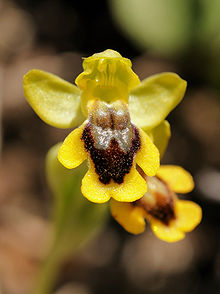- Chemical mimicry
-
 Ophrys lutea, an orchid species with flowers that mimic the pheromones of female insects
Ophrys lutea, an orchid species with flowers that mimic the pheromones of female insects
Chemical mimicry is mimicry[1] mediated via chemoreception (the chemical senses of smell and taste). Chemical mimicry may be used in combination with mimicry in other sensory modes (e.g. visual, auditory, tactile) or by itself. This sort of mimicry is less obvious to humans and thus has not received as much attention from researchers as other forms (like visual mimicry) have.[2] Examples include spiders mimicking sex pheromones of moths in order to catch them,[3] and plant mimicry of insect alarm pheromones which stops them from attacking the plant.[4]
Contents
Examples
The attraction of male insects to sex pheromones is exploited by a number of parties. Because finding a mate is essential for a male's reproductive success, there is strong selection on males to respond to these chemical signals. Other signallers can benefit from mimicking these pheromones, for example bolas spiders, orchids or even other males of the same species (intraspecific mimicry).[5]
Some plants have their seeds dispersed by ants, a phenomenon called myrmecochory. Seeds have a nutritious attachment called an elaiosome which functions as a food reward for the ants. In some cases the elaiosomes seem to chemically mimic insect prey. Brew et al. (1989) write that "[w]hile the nutrient composition of elaiosomes may provide the underlying selective advantage for ants in seed dispersal, specific compounds may manipulate their behaviour and maximize seed dispersal."[6]
See also
References
- ^ Mimicry is a difficult phenomenon to define. Approximately, one group of living things is perceived to be similar to another group (usually group = species) by a signal receiver, benefiting the signaller and (normally) harming the receiver
- ^ Dettner, K.; Liepert, C. (1994). "Chemical mimicry and camouflage". Annual Review of Entomology 39: 129–154. doi:10.1146/annurev.en.39.010194.001021.
- ^ Yeargan, K.V. (1994). "Biology of bolas spiders". Annual Review of Entomology 39: 81–99. doi:10.1146/annurev.en.39.010194.000501.
- ^ Gibson, R.W.; Pickett, J.A. (1983). "Wild potato repels aphids by release of alarm pheromone". Nature 302 (5909): 608–609. doi:10.1038/302608a0.
- ^ Wyatt, Tristram D. (2003). Pheromones and Animal Behaviour. Cambridge: Cambridge University Press. p. 240. ISBN 0 521 48526 6.
- ^ Brew, C.R.; O'Dowd, D.J.; Rae, I.D. (1989). "Seed dispersal by ants: behaviour-releasing compounds in elaiosomes". Oecologia 80 (4): 490–497. doi:10.1007/BF00380071.
Further reading
- Buhner, Stephen (2002). The Lost Language of Plants. Vermont: Chelsea Green.
- Stowe, M.K. (1998). "Chemical Mimicry". In K.C. Spencer (ed). Chemical Mediation of Coevolution. London: Academic Press.
- Bernklau, E.J (1996). "Chemical Mimicry in Pollination". Colorado State University. http://www.colostate.edu/Depts/Entomology/courses/en570/papers_1996/bernklau.html. Retrieved 2010-05-02.
Classification TaxonomyModalityChemical · AuditoryBatesian · Müllerian · Mertensian · Automimicry · Pseudocopulation · Sexual · Vavilovian · Eyespots · Aggressive
Related topics Antipredator adaptation · Animal communication · Aposematism · Camouflage/Crypsis · Co-evolution · Animal coloration · Community ecology · Evolution of mimicry · Evolutionary ecology · Frequency dependent selection · Polymorphism · Signalling theory · Underwater camouflage and mimicryCategories:
Wikimedia Foundation. 2010.
